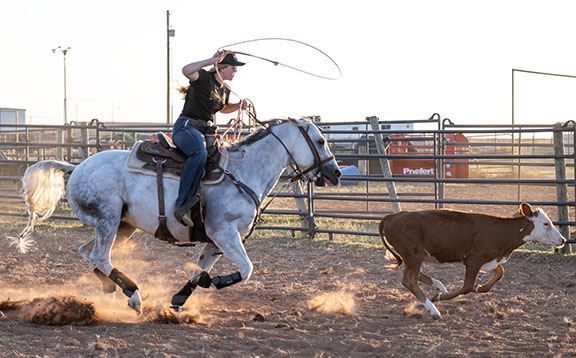Unless you are a member of the rodeo team, you might not really understand this sport. Here’s some information that can help.
Most of the events the Ranger rodeo team competes in require the participants to complete an activity quickly, so the faster the individual is, the more points — and cash — he or she wins.
Three events — saddle bronc riding, bull riding and bareback riding — require the participants to remain atop a bucking animal for eight seconds. The animal and the rider each receive a score, which is combined for the total score for each participant.
Timed events
Tie down calf roping — rider (usually men) on horseback lassos a calf, then dismounts and ties its legs together.
Breakaway calf roping — rider (usually women) on horseback ropes a calf but does not dismount or throw or tie the calf. Instead, when the rope runs out, the rider pulls it tight and a string attaching the rope to the saddle horn breaks, ending the run.
Steer wrestling/bulldogging — rider on horseback rides alongside a steer, grabs its horns, slides off the horse and wrestles the steer to the ground.
Goat tying — rider (usually women) on horseback gallops to a goat staked on a 10-foot rope about 100 feet away, dismounts, catches the goat, puts it on its side and ties three of its legs together. The goat must stay tied for six seconds to count.
Team roping — two riders (men or women) on horseback work together to rope and immobilize a steer. The header ropes the steer first; then the heeler ropes the hind feet.
Barrell racing — rider (women) on horseback run a cloverleaf pattern around preset barrels.
Judged events
Bull riding — a rider must stay atop the bucking bull for eight seconds, using only one hand to hang on, and then is judged on the quality of his ride. He can receive up to 50 points. That score is combined with a score for the animal’s performance (also a possible 50 points) for a total score.
Saddle bronc riding — a rider must stay on a bucking, saddled horse for eight seconds, with one hand never touching the horse. The horse and rider are each scored up to 50 points on performance for a combined total score. Judges evaluate the rider’s control and spurring as well as the horse’s bucking.
Bareback riding — similar to saddle bronc, riders must stay on a bucking horse without a saddle for eight seconds, using only one hand to hold on. Again both the animal and rider are scored by judges for up to 50 points each, which is combined for a total score.
How rodeo competition works
Competitors can have multiple chances to win points and money in the events they enter.
Long go/first go —This is the first opportunity for each participant to make points during scheduled performances. The fastest times in timed events earns the most points and money with slower times earning fewer points and less or no money. Those who score the highest in saddle bronc, bull riding and bareback riding also win the most money. Even people who place may win money, depending on how much money is allotted to each event.
Short go — The highest placing individuals in the first go can compete again in the short go. Fastest times/highest scores again earn the most points and win more money.
Average — This is not an average as typically found in math, but rather a total of the first go and second go times or scores. Fastest total times again earn the most points and even more money.
Total — Points earned in the first go, short go and average are added together, and the individual with the most points wins the overall event. Each participant also takes home all the money won in each round and average regardless of the final placing.
Slack — When more contestants are entered than can participate during the scheduled performances, the extra participants compete at other times, often in the morning when the scheduled rodeos are at night.
These participants can still win points and money just as if they competed in the regular performances.
Cost to participate
Each contestant in the Central Plains Region, which includes Northwestern, must pay entry fees ($40 per event) plus other charges for stock, timers, secretary/office, director and awards.
—Source: Various online sites

